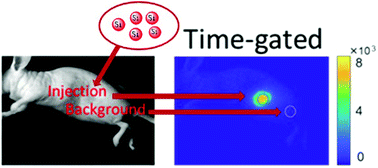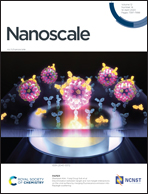Water-soluble silicon nanocrystals as NIR luminescent probes for time-gated biomedical imaging†
Abstract
Luminescent probes based on silicon nanocrystals (SiNCs) have many advantages for bioimaging compared to more conventional quantum dots: abundancy of silicon combined with its biocompatibility; tunability of the emission color of SiNCs in the red and NIR spectral region to gain deeper tissue penetration; long emission lifetimes of SiNCs (hundreds of μs) enabling time-gated acquisitions to avoid background noise caused by tissue autofluorescence and scattered excitation light. Here we report a new three-step synthesis, based on a low temperature thiol–ene click reaction that can afford SiNCs, colloidally stable in water, with preserved bright red and NIR photoluminescence (band maxima at 735 and 945 nm for nanocrystals with diameters of 4 and 5 nm, respectively) and long emission lifetimes. Their luminescence is insensitive to dioxygen and sensitive to pH changes in the physiological range, enabling pH sensing. In vivo studies demonstrated tumor accumulation, 48 hours clearance and a 3-fold improvement of the signal-to-noise ratio compared to steady-state imaging.

- This article is part of the themed collections: Bioorthogonal and click chemistry: Celebrating the 2022 Nobel Prize in Chemistry and Advisory Board research selection


 Please wait while we load your content...
Please wait while we load your content...